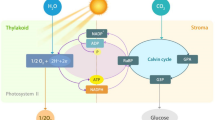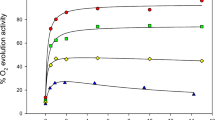Abstract
Transmission electron microscopy revealed the presence of electron-dense bodies (EDB) in the cytosol of the acidophilic, thermophilic red alga Cyanidium caldarium. These bodies contain almost exclusively Fe, P, and O and can play a role in Fe storage. 31P-nuclear magnetic resonance analysis identified a sharp signal at −23.3 ppm, which was attributed to the phosphate groups of the inner portions of polyphosphate chains. From this evidence, as well as that of a previous ESR study (Nagasaka et al., BioMetals 16:465–470, 2003), it can be concluded that polyphosphates are the major anionic constituents of the EDB. Omission of Fe from the culture medium resulted in substantially decreased polyphosphate levels, demonstrating the control of cellular polyphosphate content by the Fe status of the culture medium.

Similar content being viewed by others
References
Geitler L (1933) Diagnosen neuer Blaualgen von den Sunda-Inseln. Arch Hydrobiol Suppl 12:622–634
Nagasaka S, Nishizawa NK, Negishi T, Satake K, Mori S, Yoshimura E (2002) Novel iron-storage particles may play a role in aluminum tolerance of Cyanidium caldarium. Planta 215:399–404
Nagasaka S, Nishizawa NK, Watanabe T, Mori S, Yoshimura E (2003) Evidence that electron-dense bodies in Cyanidium caldarium have an iron-storage role. BioMetals 16:465–470
Yoshimura E, Nagasaka S, Satake K, Mori S (2000) Mechanism of aluminium tolerance in Cyanidium caldarium. Hydrobiologia 433:57–60
Allen MB (1959) Studies with Cyanidium caldarium, an anomalously pigmented chlorophyte. Archiv Mikrobiol 32:270–277
Kumble KD, Kornberg A (1995) Inorganic polyphosphate in mammalian cells and tissues. J Biol Chem 270:5818–5822
van Voorthuysen T, Regierer B, Springer F, Dijkema C, Vreugdenhil D, Kossmann J (2000) Introduction of polyphosphate as a novel phosphate pool in the chloroplast of transgenic potato plants modifies carbohydrate partitioning. J Biotechnol 77:65–80
Dawson MJ, Gadian DG, Wilkie DR (1977) Contraction and recovery of living muscles studies by 31P nuclear magnetic resonance. J Physiol 267:703–735
Kime MJ, Ratcliffe RG, Williams RJP, Loughman BC (1982) The application of 31P nuclear magnetic resonance to higher plant tissue. I. Detection of spectra. J Exp Bot 33:656–669
Gómez-García MR, Kornberg A (2004) Formation of an actin-like filament concurrent with the enzymatic synthesis of inorganic polyphosphate. Proc Natl Acad Sci U S A 101:15876–15880
Kumble KD, Kornberg A (1996) Endopolyphosphatases for long chain inorganic polyphosphate in yeast and mammals. J Biol Chem 271:27146–27151
Harold FM (1966) Inorganic polyphosphates in biology: structure, metabolism, and function. Bacteriol Rev 30:772–794
Beever RE, Burns DJW (1980) Phosphorus uptake, storage and utilisation by fungi. Adv Bot Res 8:127–219
Kulaev IS, Vagabov VM (1983) Polyphosphate metabolism in micro-organism. Adv Microb Physiol 24:83–171
Goldberg J, Gonzalez H, Jensen TE, Corpe WA (2001) Quantitative analysis of the elemental composition and the mass of bacterial polyphosphate bodies using STEM EDX. Microbios 106:177–88
Jensen TE, Corpe WA (1994) Picoplanktonic cyanophytes from three small lakes with special reference to polyphosphate bodies. Arch Hydrobiol Suppl Algol Stud 75:149–156
Author information
Authors and Affiliations
Corresponding author
Rights and permissions
About this article
Cite this article
Nagasaka, S., Yoshimura, E. External Iron Regulates Polyphosphate Content in the Acidophilic, Thermophilic Alga Cyanidium caldarium . Biol Trace Elem Res 125, 286–289 (2008). https://doi.org/10.1007/s12011-008-8177-9
Received:
Accepted:
Published:
Issue Date:
DOI: https://doi.org/10.1007/s12011-008-8177-9




